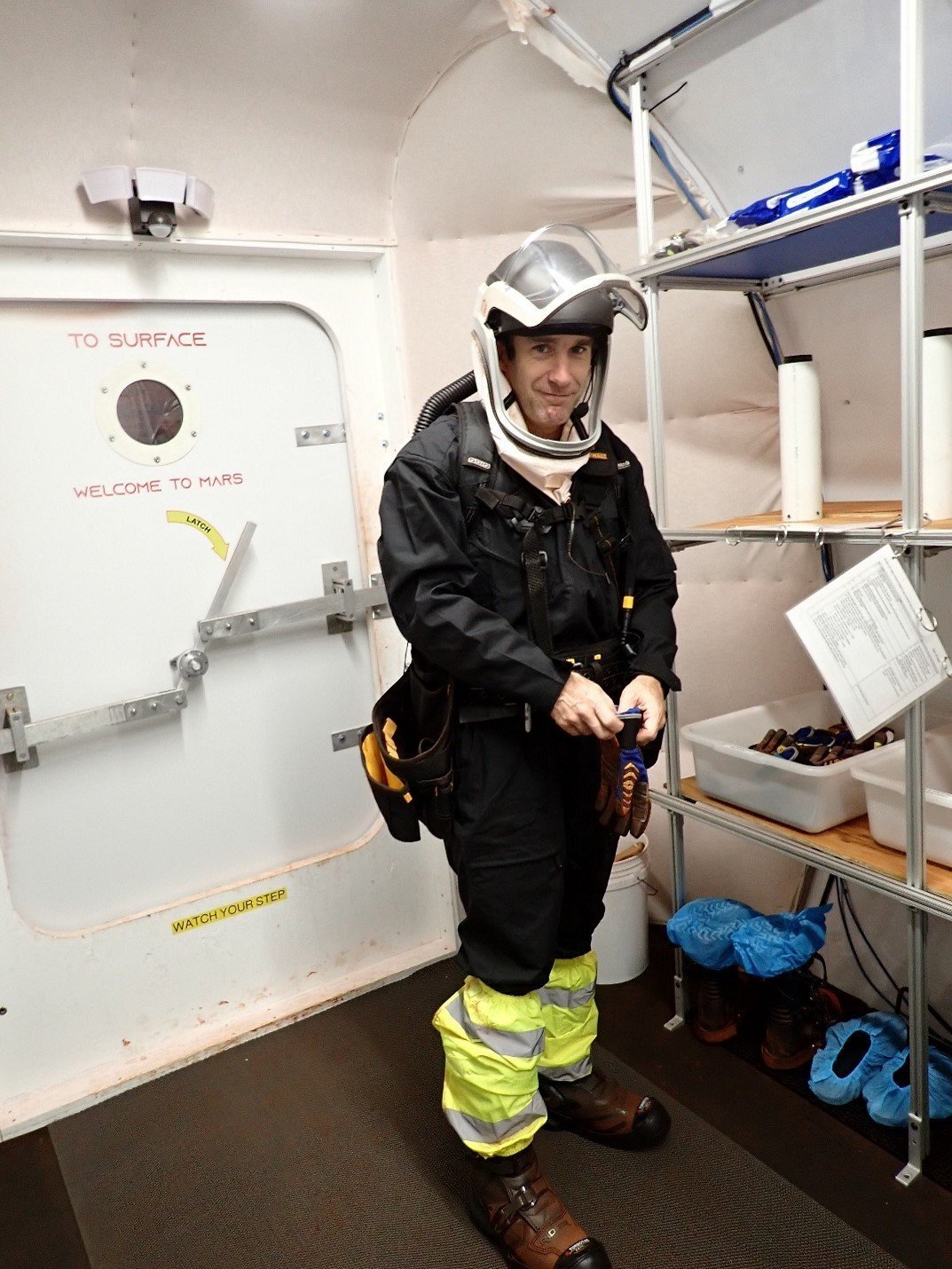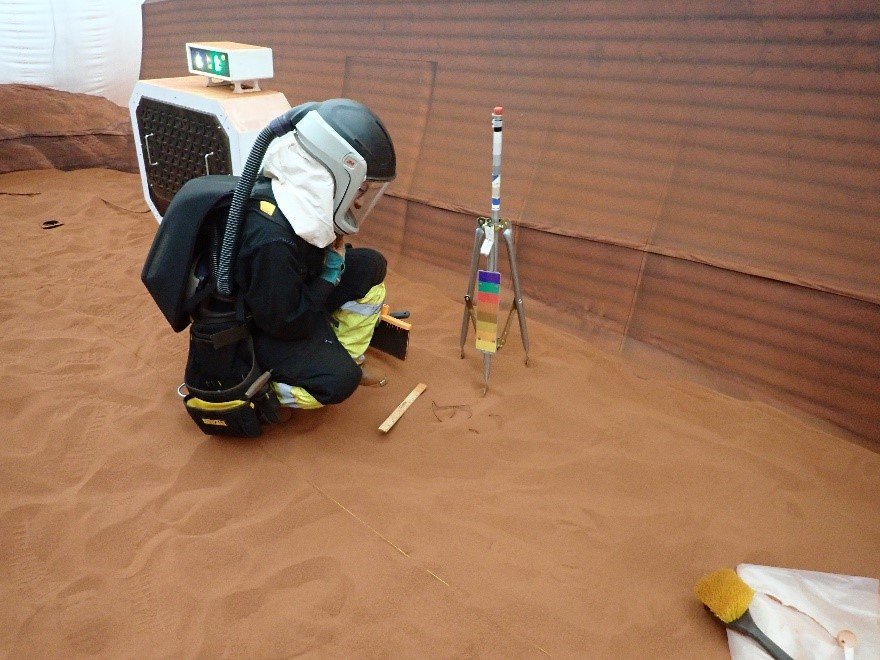Mars, Texas Pt. 2: What Life Is Like Inside a NASA Simulation
Ross Brockwell, Crew Health and Performance Exploration Analog (CHAPEA) mission 1 flight engineer, completes a simulated extravehicular activity. Image: NASA
By Elise Cutts (BS ’19)
Read the first part of Caltech magazine’s interview with Brockwell, completed before he began his mission.
It has been more than six months since Caltech alumnus Ross Brockwell (MS ’01) left his life in Virginia Beach to serve as the flight engineer for NASA’s first Crew Health and Performance Exploration Analog (CHAPEA) mission. He and three crewmates are spending a year enclosed in a 1,700 square-foot, 3D-printed habitat called Mars Dune Alpha to simulate the psychological and physical demands of a real Mars mission. The crew even carries out missions on the “Martian” surface, occasionally with the aid of virtual reality.
The mission also simulates how hard it is to contact an astronaut on Mars. It takes about 13 to 22 minutes each way for a message traveling at light-speed to reach the Red Planet, and the bandwidth for sending messages is low, meaning only a limited amount of information can be sent back and forth each day. Luckily, Caltech magazine got a message through. We checked in with Brockwell at the halfway point of his mission to find out how his year in Mars, Texas, has been going.
What was the most tense or exciting situation you have faced so far?
It was really fun and exciting to do our first extravehicular activity, or EVA (a mission outside the habitat to an area filled with red sand meant to mimic the Martian landscape) to put myself in my mind on the surface of Mars, stepping out for the first time. What an absolutely amazing moment that will be! It’s exciting to think that moment will happen for humankind, for Earth, in the future.
What is your life like “on Mars?” Walk us through a normal day, if there is one.
We generally wake up at the same time each morning and have a few specific daily tasks, then we have breakfast and a team meeting together. From there, everyone’s individual schedule will deviate, but they usually involve habitat maintenance, tasks related to our crew-specific roles, science, training, and exercise. EVAs become a substantial part of the schedule when we have them. The evenings involve dinner together, some free time, and some time for personalized training, communications, or relaxing. We do a few things to help keep our circadian rhythms regular, and we generally go to bed about the same time each night.
What is one thing that surprised you about the mission? And what is one thing that was pretty much exactly as you expected it to be?
I was a bit surprised by how spacious the habitat feels. I wondered if and when I would really start to feel confined. But I am continually pleased with how it lives, and imagining the surface of Mars outside the walls, putting yourself there mentally, definitely makes it feel like it’s a protective home base for an epic adventure!
In a very pleasantly unsurprising way, the dynamic with this crew is pretty much exactly as I had expected. Four people living in a small space will have its challenges, of course, but this crew got pretty tight very quickly. We have a lot of fun together, and there is a lot of consideration and mutual understanding, as well as a high level of effectiveness meeting the challenges of the mission.
How did you and your crewmates celebrate the fall and winter holidays?
We have managed to have a good time with the holidays, and even put together some pretty impressive decorations, I must say. We put up a Christmas tree and everyone got creative with the resources available to us here, and we made some gifts for each other. New Year’s was also the midpoint of the mission, so it was a special celebration.
You mentioned in your first chat with us that Caltech prepared you to “connect theory and practice” in ways that you anticipated would be helpful on the mission. Have you encountered any situations in which that skill came in handy?
One example might be developing designs for things we need to 3D print. With the energy, time, and difficulty required to send things to Mars, a Mars mission will need the capability to design and create parts in situ. I’ve always remembered a class at Caltech where we derived the formulas that describe how stress concentrates at the corners of openings in materials, which conveyed a deeper understanding of something that I had been more loosely intuiting. It also improved my understanding of numerical methods of analysis. I’m using software for the creation of these parts that I had never used before, and some understanding of what the software is likely trying to resolve helped me learn it well enough to create parts we have needed to replace or needed to create for some specific function.
Is there anything we did not ask about that you would like to add?
I might just take the opportunity to try and express how important I think it is for humankind to be curious and to explore space, and how exciting and amazing it is that we are at the point in history where we are really working toward going to Mars.
I’d also like to reiterate an important point: That it’s never been, nor will it ever be either/or between Mars and Earth. Earth is our home and is still a paradise that we must treat as irreplaceable. Mars is not an alternative to stewardship of the earth, but it is also not a waste of energy and resources to venture to other worlds. Space exploration is absolutely worth our effort and risk. It is such an important endeavor for humankind, and therefore for planet Earth. It addresses a fundamental need for us, and it is such an incredible opportunity to inspire and connect all of humanity. It can help us transcend our perspective, literally and philosophically, and to cherish our home and our place in the universe.





